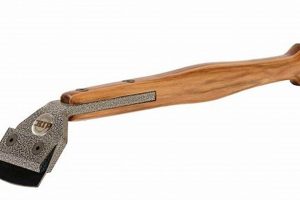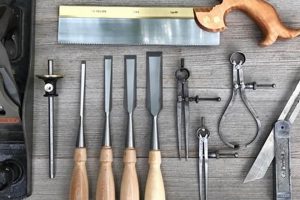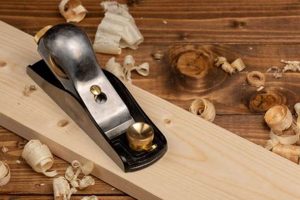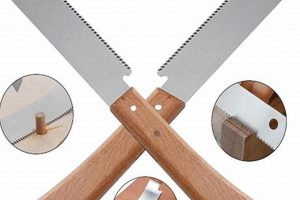A collection of essential implements tailored for individuals beginning their journey into the craft of shaping wood manually. Such a collection typically includes tools for measuring, marking, cutting, shaping, and joining wood. An example might feature a hand saw, chisels, a block plane, a measuring tape, a marking gauge, and a sharpening stone.
Acquiring a comprehensive set offers several advantages. It provides a foundational basis for developing woodworking skills, allowing the artisan to understand the properties of wood and the mechanics of shaping it. Furthermore, these tools are historically significant, representing a connection to traditional methods of craftsmanship that predate mechanized production. The use of hand tools fosters precision, control, and a deeper understanding of the materials.
The following sections will delve into the specific tools commonly found within these collections, exploring their individual functions and providing guidance on their selection and maintenance, which is vital for anyone starting out in this craft.
Essential Guidance for the Aspiring Woodworker
The selection and use of a curated set of manual implements is a critical first step in developing woodworking expertise. The following tips offer guidance on maximizing the value and longevity of such a collection.
Tip 1: Prioritize Quality over Quantity: Initially, focus on acquiring fewer, higher-quality tools. Durable, well-made tools will perform better and last longer, providing a more satisfying and efficient experience.
Tip 2: Invest in Sharpening Equipment: Sharp tools are safer and more effective. A sharpening stone, honing guide, and strop are essential for maintaining cutting edges. Dull tools are a leading cause of accidents and poor results.
Tip 3: Learn Proper Tool Maintenance: Regularly clean and oil tools to prevent rust and corrosion. Proper storage in a dry environment is also critical. Neglecting maintenance will shorten the lifespan and reduce the performance of the equipment.
Tip 4: Start with Basic Projects: Begin with simple projects to familiarize with the tools and techniques. This approach allows for a gradual learning curve and prevents frustration. Avoid complex joinery or intricate designs in the early stages.
Tip 5: Research and Experiment with Different Wood Species: Understanding the properties of various woods is crucial. Experiment with softwoods and hardwoods to learn how they respond to different tools and techniques.
Tip 6: Practice Proper Body Mechanics: Woodworking can be physically demanding. Employ proper posture and leverage to minimize strain and prevent injuries. Consider taking a class on ergonomic tool usage.
Tip 7: Secure a Stable Work Surface: A solid workbench is essential for stability and control. Ensure the workbench is properly anchored and provides adequate support for the workpiece. A wobbly or unstable workbench increases the risk of accidents and inaccuracies.
These guidelines serve to establish a solid foundation for woodworking endeavors. By prioritizing quality, maintenance, and safe practices, the aspiring woodworker can maximize the potential of this classic art form.
The subsequent sections will provide detailed information on specific tool types and advanced woodworking techniques.
1. Essential implements
The term “essential implements” directly defines the core components of a fundamental woodworking collection. A “woodworking hand tools starter kit” is a curated selection of these implements. The absence of essential tools renders the kit incomplete and undermines its purpose: enabling a novice to begin woodworking. For example, a collection without a saw or a chisel would preclude basic cutting and shaping tasks, severely limiting the user’s ability to execute even simple projects. Therefore, selecting the right core tools is paramount to the kit’s success.
The specific tools deemed essential vary depending on the type of woodworking envisioned. A kit geared towards furniture making will necessitate tools for precise joinery, such as chisels, planes, and marking gauges. Conversely, a kit intended for carving might prioritize gouges and specialized knives. Practical application of this understanding involves carefully assessing the user’s intended projects and selecting implements accordingly. Purchasing a general-purpose kit without considering specific needs often results in redundancy or crucial omissions. A real life example is purchasing a kit without a mallet when the plan calls for heavy chiseling.
In summary, the understanding of what constitutes “essential implements” is fundamental to the design and effectiveness of a “woodworking hand tools starter kit.” Selection criteria must be driven by project requirements and a realistic assessment of the user’s skill level. Challenges arise when balancing cost constraints with the need for quality tools. A well-curated set, prioritizing quality and relevance, significantly enhances the learning experience and long-term success of the aspiring woodworker.
2. Material properties
The properties of wood directly influence the selection and application of tools within a fundamental woodworking collection. Hardness, grain direction, density, and moisture content are critical factors that dictate the appropriate tools for cutting, shaping, and joining. Utilizing unsuitable implements can result in inefficient work, damaged materials, or unsafe working conditions. For example, attempting to cut a dense hardwood with a saw designed for softwoods will lead to blade binding, increased effort, and a poor cut quality.
Understanding the relationship between wood characteristics and tool functionality allows for the effective application of specific techniques. When working with fine-grained woods, a sharp, low-angle plane is essential for achieving smooth surfaces without tear-out. Conversely, coarser-grained woods might require specialized saws with larger teeth to prevent clogging. Furthermore, knowledge of moisture content is vital to prevent wood movement and subsequent joint failure after assembly. Wood selection is as important as tool selection. Seasoned vs unseasoned wood changes how tools interact and will have direct effect on the end goal of the project.
In conclusion, a comprehensive understanding of material properties is integral to the effective use and selection of a curated set of woodworking instruments. This knowledge enables informed decisions regarding tool choice, optimizes performance, and contributes to the creation of durable and aesthetically pleasing woodworking projects. Neglecting material properties leads to inefficient workflows, potential material waste, and ultimately, compromised project outcomes. The selection of tools should consider common materials used and expand knowledge when necessary.
3. Skill development
The acquisition of woodworking skills is fundamentally linked to the tools employed. A curated collection provides the initial platform for developing proficiency. Effective utilization of manual implements requires a gradual learning process, where each skill builds upon the preceding one, ultimately fostering mastery of the craft.
- Tool Familiarization
Initial skill development centers on understanding the function and safe operation of each tool within the collection. This involves learning proper grip, stance, and cutting techniques. For example, accurately using a hand saw requires developing a consistent sawing motion, maintaining blade alignment, and applying appropriate pressure. Without this fundamental understanding, achieving clean, accurate cuts is impossible.
- Material Handling
Proficiency in woodworking extends beyond the tools themselves and encompasses understanding how different wood species respond to various shaping techniques. Skill development involves learning to recognize grain direction, identify potential defects, and adapt techniques accordingly. A skilled woodworker can anticipate how a particular wood will react to a chisel or plane, minimizing tear-out and maximizing efficiency. This type of knowledge comes with experience.
- Joinery Techniques
The ability to create strong and aesthetically pleasing joints is a hallmark of skilled woodworking. A collection provides the implements necessary to practice fundamental joinery techniques such as dovetails, mortise and tenon joints, and rabbets. Developing these skills requires precision, patience, and a thorough understanding of wood behavior. Successful joinery relies on accuracy measured through tool control.
- Sharpening and Maintenance
Maintaining sharp tools is critical for both safety and efficiency. Skill development encompasses learning proper sharpening techniques, including honing and grinding. A sharp tool requires less force, resulting in cleaner cuts and reduced risk of injury. The maintenance of tools will not only save money but will also require additional skills that are crucial to master.
These aspects of skill development are intrinsically tied to the quality and completeness of a collection. A well-curated selection of implements provides a solid foundation for acquiring the necessary skills to progress from novice to proficient woodworker. Each project undertaken presents an opportunity to refine existing skills and develop new ones, ultimately leading to a deeper appreciation of the craft.
4. Safety protocols
Adherence to established safety protocols is paramount when utilizing manual implements, particularly for individuals commencing their journey into woodworking. The effective use of a collection mandates a thorough understanding and consistent application of safety measures to mitigate potential risks inherent in the craft.
- Personal Protective Equipment (PPE)
The consistent use of appropriate PPE is indispensable. Safety glasses or goggles protect the eyes from flying debris. Hearing protection is crucial in environments with prolonged exposure to loud noises, such as hammering or sawing. Gloves safeguard hands from splinters and sharp edges. A dust mask or respirator is vital to prevent the inhalation of fine wood particles, which can cause respiratory irritation and long-term health problems. The selection of appropriate PPE should align with the specific tasks being performed.
- Tool Condition and Maintenance
The condition of the tools directly impacts safety. Dull tools require more force, increasing the risk of slippage and injury. Regular sharpening is essential to maintain optimal cutting performance. Damaged tools, such as those with cracked handles or loose blades, must be repaired or replaced immediately. Neglecting tool maintenance compromises safety and reduces efficiency.
- Work Area Organization
A well-organized work area minimizes the risk of accidents. Adequate lighting is essential for clear visibility. Clutter and obstructions should be removed to prevent tripping hazards. The workbench must be stable and provide sufficient support for the workpiece. Proper ventilation is necessary to dissipate dust and fumes. A designated first-aid kit should be readily accessible. An organized work area promotes focused and safe work habits.
- Safe Work Practices
Safe work practices are fundamental to injury prevention. Secure the workpiece firmly before beginning any cutting or shaping operation. Always cut away from the body. Keep hands clear of the cutting path. Avoid distractions while working. Take frequent breaks to prevent fatigue, which can impair judgment and increase the risk of errors. Seek guidance from experienced woodworkers or instructional resources to learn proper techniques. Develop habits and stick to them.
These facets of safety protocols are inextricably linked to the effective and responsible use of a curated set of manual woodworking instruments. Prioritizing safety ensures a productive and enjoyable woodworking experience, minimizing the potential for accidents and promoting a culture of conscientious craftsmanship.
5. Maintenance practices
Proper maintenance constitutes a critical aspect of ensuring the longevity, performance, and safety of a manual woodworking instrument set. Consistent and diligent maintenance practices preserve the utility of such implements and guarantee their continued effectiveness over time.
- Sharpening and Honing
Maintaining sharp cutting edges on tools such as saws, chisels, and planes is paramount. Dull tools necessitate increased force, elevate the risk of slippage, and produce substandard results. Regular sharpening, employing stones of varying grit, restores the cutting edge. Honing refines this edge, achieving optimal sharpness. Ignoring this facet leads to inefficient work and potential injury.
- Cleaning and Lubrication
Woodworking generates dust and resin buildup, which can compromise tool performance and accelerate corrosion. Regular cleaning with a brush and appropriate solvent removes debris. Subsequent lubrication with a light oil prevents rust formation, particularly in humid environments. Neglecting this aspect diminishes tool lifespan and increases the likelihood of operational malfunctions.
- Handle and Body Inspection
Handles of tools such as chisels, hammers, and saws are subject to wear and potential damage. Regular inspection for cracks, splits, or loose connections is essential. Timely repair or replacement of compromised handles ensures safe and comfortable operation. Similarly, the bodies of planes and other metal tools should be inspected for damage or distortion, which can affect performance and accuracy.
- Proper Storage
Incorrect storage can lead to tool damage, corrosion, and reduced lifespan. Storing tools in a dry, protected environment prevents rust and protects wooden components from moisture-related issues. Organizing tools in a designated space minimizes the risk of accidental damage and facilitates easy access. Individual sheaths or protective cases safeguard cutting edges and prevent injuries.
The implementation of these maintenance practices directly impacts the sustained value and utility of a manual woodworking instrument set. Consistent attention to these details ensures the instruments remain effective, safe, and reliable, providing a foundation for successful woodworking endeavors. Furthermore, this can reduce the need for costly replacements and allows for consistent quality in the projects undertaken.
6. Project complexity
The scope of woodworking projects directly dictates the adequacy and effectiveness of a manual instrument collection. As project complexity increases, the limitations of a rudimentary set become progressively apparent, necessitating supplemental tooling and advanced techniques. The correlation between project ambition and tool requirements is a central consideration for the aspiring woodworker.
- Scale and Dimensions
Larger projects, such as constructing furniture or cabinetry, demand tools capable of processing substantial material volumes accurately. A starting set may lack the necessary saw sizes or plane capacities for efficiently handling large panels or timbers. Inadequacy in this area translates to increased labor, reduced precision, and potential project compromises. For instance, attempting to build a large table with a small block plane will result in uneven surfaces and protracted completion times.
- Joinery Intricacy
Complex joinery techniques, such as dovetailing or mortise-and-tenon construction, necessitate specialized implements for precise execution. A rudimentary collection may provide basic chisels but lack the refinement required for intricate joint creation. This limitation forces reliance on simplified joinery methods or necessitates the acquisition of supplemental tools, such as dovetail saws or specialized marking gauges. For example, making a complex dovetail joint may not be possible without a proper dovetail saw.
- Material Diversity
Projects involving a wide range of wood species or composite materials place additional demands on the instrument collection. Different woods exhibit varying hardness, grain structure, and workability, necessitating tools optimized for specific material properties. A starting set may prove inadequate for processing particularly dense hardwoods or delicate veneers, potentially leading to tool damage or substandard results. The use of exotic hardwoods with complex grain patterns may require specialized tools.
- Finishing Requirements
Projects with stringent finishing requirements demand tools capable of producing exceptionally smooth and consistent surfaces. A starting collection may lack the specialized planes or scrapers necessary for achieving a flawless finish. This limitation necessitates reliance on alternative methods, such as sanding, which may compromise the sharpness of details or introduce imperfections. For example, removing plane marks on a cherry tabletop will not be easy without proper smoothing plane.
As demonstrated, project complexity is a decisive factor in evaluating the suitability of a starting set. While a basic collection provides a foundation for elementary woodworking tasks, ambitious projects invariably require supplemental tooling and advanced techniques. An honest assessment of project goals and skill level is crucial in determining whether a specific is adequately equipped for the task at hand.
7. Cost considerations
The financial aspect is a significant determinant in the acquisition of a foundational woodworking instrument set. The available budget dictates the quality, quantity, and type of tools that can be acquired, directly influencing the scope and potential of initial woodworking endeavors.
- Initial Investment versus Long-Term Value
A primary consideration involves balancing the immediate cost of implements with their projected lifespan and performance. Lower-priced tools may offer an attractive entry point, but often compromise on materials and construction quality. Such tools may require more frequent replacement or necessitate extensive modifications to achieve satisfactory results. Conversely, higher-quality tools, while requiring a greater initial investment, typically offer superior durability, precision, and overall value over time. The selection of a cheaper tool to save cost can prove to be more expensive due to frequent replacement. For example, a high-quality hand plane, though initially costing more, may last a lifetime with proper care, while a cheaper alternative may require replacement within a few years.
- Essential versus Desirable Tools
Distinguishing between tools that are fundamental to basic woodworking tasks and those that enhance efficiency or expand capabilities is critical for budget management. Prioritizing essential implements ensures that core functions, such as cutting, shaping, and joining, can be effectively performed. Desirable tools, while offering increased convenience or specialized functionality, can be deferred until the budget allows. For example, investing in a high-quality hand saw and chisels is generally more prudent than purchasing an array of less frequently used specialty tools at the outset.
- New versus Used Tools
The option of acquiring used tools presents a potential avenue for cost savings. Used tools, particularly vintage hand planes and saws, can often be obtained at significantly lower prices than their new counterparts. However, purchasing used tools requires careful inspection to assess their condition and ensure that they are in good working order or can be readily restored. This approach necessitates a degree of knowledge and expertise to identify potential issues and avoid purchasing tools that are beyond repair. Buying used tools can be effective if a woodworker understands the repair or refurbishment process.
- Component-Based Acquisition versus Pre-Assembled Sets
The decision to purchase tools individually or as part of a pre-assembled collection impacts overall cost. Pre-assembled sets offer the convenience of acquiring a range of tools at a potentially discounted price. However, the contents of such sets may not perfectly align with individual needs or preferences. Component-based acquisition allows for greater customization, enabling the woodworker to select tools that precisely meet their requirements. This approach may result in a higher overall cost but ensures that each tool is of the desired quality and functionality.
These facets of cost considerations highlight the need for careful planning and informed decision-making when acquiring an introductory woodworking set. Balancing budgetary constraints with the long-term value and functionality of implements is essential for establishing a solid foundation for successful woodworking endeavors.
Frequently Asked Questions
The following section addresses common inquiries regarding essential woodworking hand tool sets designed for novice artisans.
Question 1: What constitutes a comprehensive initial woodworking instrument collection?
A comprehensive set typically includes a hand saw, chisels, a block plane, a measuring tape, a marking gauge, a sharpening stone, and a mallet. This selection facilitates basic cutting, shaping, and joining operations, providing a foundation for skill development.
Question 2: Is it advisable to prioritize quality over quantity when acquiring manual woodworking implements?
Yes. Investing in fewer, higher-quality tools generally yields superior performance, increased durability, and a more satisfying user experience. Durable tools minimize the need for frequent replacements and reduce the risk of operational malfunctions.
Question 3: What role does sharpening equipment play in maintaining a curated woodworking instrument set?
Sharpening equipment, such as sharpening stones, honing guides, and strops, is essential for maintaining optimal cutting performance. Sharp tools require less force, produce cleaner cuts, and reduce the risk of injury. Regular sharpening prolongs the lifespan of cutting edges.
Question 4: How does the choice of wood species impact the selection and application of tools within a fundamental collection?
Different wood species exhibit varying hardness, grain structure, and workability. These properties necessitate tools optimized for specific material characteristics. Understanding the relationship between wood characteristics and tool functionality is crucial for achieving optimal results.
Question 5: What safety precautions should be observed when utilizing a manual woodworking instrument set?
Consistent use of personal protective equipment (PPE), such as safety glasses, hearing protection, and dust masks, is indispensable. Maintaining tools in good condition, organizing the work area, and adhering to safe work practices are also essential for injury prevention.
Question 6: How does project complexity influence the suitability of a curated woodworking instrument collection?
Increasing project complexity demands a greater range of tools and specialized techniques. A starting collection may prove inadequate for projects involving large dimensions, intricate joinery, or diverse materials. Assessing project goals and skill level is crucial for determining the suitability of the toolset.
In summary, selecting, maintaining, and utilizing a fundamental woodworking instrument set requires careful consideration of quality, material properties, safety protocols, and project scope. Informed decisions regarding these factors contribute to a productive and rewarding woodworking experience.
The following sections will address tool storage and workspace organization.
Conclusion
This exploration of the “woodworking hand tools starter kit” has underscored several key factors for prospective craftspeople. The selection of quality implements, a firm understanding of material properties, adherence to safety protocols, and the consideration of project complexity are all vital to success. These elements, when harmonized, provide a solid foundation for developing woodworking skills.
The judicious assembly and responsible use of a collection enables the perpetuation of a time-honored craft. Investing in knowledge and diligent practice are essential complements to acquiring the physical tools. The enduring satisfaction derived from shaping wood with one’s own hands offers a compelling reward, underscoring the continued relevance and value of manual woodworking.







